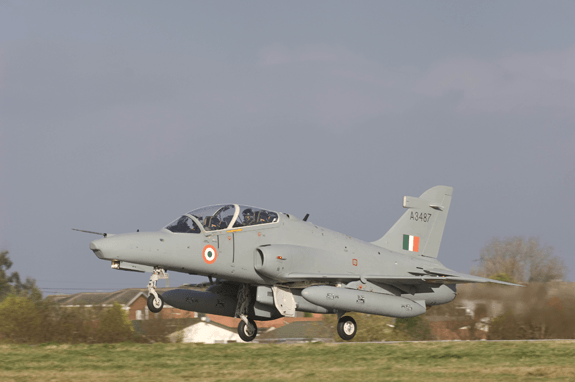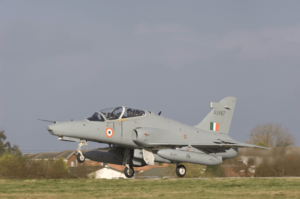An overview of the anhedral tail design configuration of the Hawk Aircraft.
| Aircraft | Hawk BAE |
| Role | Advanced Trainer Aircraft |
| Origin | United Kingdom |
| Users | Military |
| Crew | 2 |
| Manufacturer | BAE Systems |
| MTOW | 9100 kg |
| Wing Area | 16.70m2 |
| Wingspan | 9.94 m |
| Height | 3.98 m |
| Range | 2520km |
| T/W ratio | 0.65 |
| Max Speed | 0.84Mach |
The initial concept of the hawk aircraft had a frontal cross-section without the intake fairings, shown in Figure 1. The air intakes and the tailplane were placed high and had a low-wing configuration. This gave rise to an inherent issue leading to an aerodynamic profiling problem between the air intake and the wing root.

At a low Mach number, a strong vortex is developed on the upper surface of the intake. The local supersonic speed generates shock waves when coupled with the vortex and interferes with the tail. It is placed on a slightly higher plane than the wing due to which separation occurs at the shock front. Due to this, the under-surface of the horizontal stabilizer/tail suffers problems in the pitching moment arising due to non-linear variation in the pitching moment coefficient(Cm). It also has a large area with low dynamic pressure.
By reducing the tailplane height, the stability issue may increase, interpreted from the Cm vs Angle of incidence plot from the testing phase results. The effect was observed more with the low-tail plane and anhedral-tail plane configurations. The loss of stability begins at very low incidence angles (~2-3°) for low anhedral tailplanes at higher Mach number (Mach ~0.8).
On the other hand, a high tailplane configuration results in pitching moment variations at higher incidence angles (~7°). The flow around this angle of incidence deteriorated drastically on the under-surface for a low anhedral tailplane configuration. The flow separation was observed to be less affected.
The solution, here, was to fill the gap between the air intake and the wing root where the anhedral tailplane showed the best results. The modified fuselage resulted in an anhedral tailplane that gave almost no severe changes in the pitching moment coefficient, thus providing the best stability out of all the configurations.

Instead of filling the gap, the air intake was lowered to sit just above the wing and was modified to maintain the sweep between the wing root and the fuselage. The fuselage was lowered down “to a more favorable position” at the rear section, in conjunction with an anhedral tailplane. This alleviated some of the high-speed problems arising due to the placement of air intakes, wing, and tailplane initial configuration.
The idea was to place the tailplane as low as possible and most likely to place it under the tailpipe nozzle. But structurally, it was difficult to support the tailplane.
Apart from providing stability in the case of the Hawk, the anhedral tails provide a way to escape from the downwash of the wing at high angles of attack, thus, helping in decreasing the stall speed, and may assist in the install-recovery. In propeller aircraft, the anhedral tailplane may also be useful in getting the tail to clear off the “prop wash”.

Credits – The Hawk Story, Journal of Aeronautical History
* The information provided herein is, to the best of our knowledge and is only for informative purpose. If you have a news update or correction, let us know at -info@garudauniverse.com




